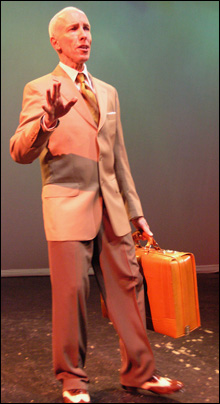 Dorothy Jungels, founder of Everett Dance Theatre (1986) and the Carriage House School and Stage (1993), has had many dreams for her company and her theater: to have the time to create new work, to have company members collaborate and learn from each other, to reach out to the community and involve them in the arts, to encourage diversity in all possible ways, and to keep the company employed. Now, in the 20th anniversary year of Everett, Jungels can look back and see how those dreams were fulfilled. She has invited many of the young people who enriched the company and the school to return for Everett All-Stars: Solo and Together at the Carriage House (April 28 and 29).
Dorothy Jungels, founder of Everett Dance Theatre (1986) and the Carriage House School and Stage (1993), has had many dreams for her company and her theater: to have the time to create new work, to have company members collaborate and learn from each other, to reach out to the community and involve them in the arts, to encourage diversity in all possible ways, and to keep the company employed. Now, in the 20th anniversary year of Everett, Jungels can look back and see how those dreams were fulfilled. She has invited many of the young people who enriched the company and the school to return for Everett All-Stars: Solo and Together at the Carriage House (April 28 and 29).
“You really don’t know how it lasted this long,” Jungels reflected in a recent phone conversation. “That’s why the All-Stars is such a great show — you get to look at all these people that made your life so rich and so happy. Sometimes, you get so serious about everything. I remember someone asking Gene Kelly what he wanted to do, and he said, he wanted to make people happy. You can’t make other people happy without making yourself happy.”
Over the years, Everett Dance Theatre has tackled some pretty unusual topics, including the work people do, the dreams they have, and the stories they remember about their families. In the process, they have worked with artists trained in drumming, clowning, new vaudeville, voice, mime, acting, film-making, and all kinds of dance. They’ve premiered each of their six evening-length pieces in New York City, where they garnered rave reviews and a Bessie Award for dance performance.
The Carriage House venue brought together young people from all over the city in the second wave of breakdancing for the first full-tilt open houses in the ’90s. It has also served as a laboratory for locally emerging choreographers, spoken word artists, filmmakers, and musicians and for nationally-known acts who might be considered too experimental to draw a crowd to a larger stage.
All of these elements come together in this weekend’s program, in which former performers and teachers, current company members, and new performers will collaborate to present scenes from Everett’s shows, plus their own work, new and re-engineered. Sokeo Ros, who came to the company as a shy high school student, now has his own hip-hop company called Case Closed, and they will back up a new narrative work by Ros titled Self-Portrait of a Stranger.
ADVERTISEMENT
 |
Ros’s group will also re-stage a segment from Somewhere In the Dream, Everett’s piece dealing with issues of race, class, and education. The original poet from Dream, Pedro Malave. and the original singers, Ana-Paula Monteiro and Tyeace McRae, will reprise their roles.
Mark Fisher, who started the breakdance program at the Carriage House and who came out of the first wave of breakdance in the ’70s, will open the show with a contemporary dance to Van Morrison’s “Moondance,” accompanied by Case Closed. He will also bring back the challenge dance he did with tapper Brian Jones, From Tap to Boom-Bap. And Jones, a frequent guest at the Carriage House, will premiere his dance, Wake Up Dreamer.
Former Everett member Eddie Silvestre will do excerpts from Translating for My Father and recreate a song from Dream, “I’m a Nobody.” Monteiro, from Dream and Body of Work will perform an original song, and McRae, from Dream, will spin out a story about her mother. Two current Everett members, Marvin Novogrodski and Bravell Smith, will present a monologue and a film, respectively. Novogrodski is weaving together a new piece from segments he did in Body of Work, Pandora Restaurant, and Out of My Mind. Smith has won national recognition for his films, and he’ll show one of the newest, La La’s Love Jones. A grand finale will including singing, dancing, and video.
“It’s a little bit of a stew of the present and the past,” Jungels remarked. “It’s a treat to look back at the role art has played in the lives of these young people and to see where they’re going. In our 20th year, we’re still full of too many dreams. We are dedicated to being here for the long run. And we’ll just keep making things and making things.”